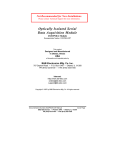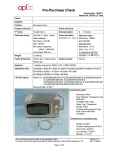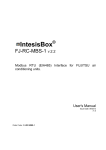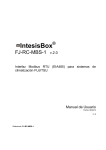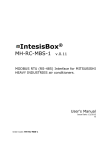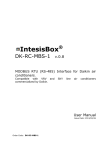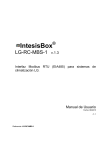Download Bard FLF085D36F Furnace User Manual
Transcript
RS-232 Digital Relay I/O Model 232DRIO Documentation Number 232DRIO1005 pn#4520-r2 This product Designed and Manufactured In Ottawa, Illinois USA of domestic and imported parts by B&B Electronics Mfg. Co. Inc. 707 Dayton Road -- P.O. Box 1040 -- Ottawa, IL 61350 PH (815) 433-5100 -- FAX (815) 433-5104 Internet: http://www.bb-elec.com [email protected] [email protected] © B&B Electronics – January 2008 232DRIO-0308 Manual Cover Page B&B Electronics -- PO Box 1040 -- Ottawa, IL 61350 PH (815) 433-5100 -- FAX (815) 433-5104 Table of Contents Chapter 1- Introduction ........................................... 3 232DRIO Features .................................................. 3 Packing List ............................................................. 2 232DRIO Specifications........................................... 3 Opto-Isolated Input................................................................ 3 Relay Outputs ....................................................................... 3 Power Supply ........................................................................ 3 Communications ................................................................... 3 Environment .......................................................................... 3 Size ....................................................................................... 3 Chapter 2 - Connections ......................................... 5 I/O Connections ............................................ ………5 Opto-isolated Input ................................................................ 5 Relay Outputs ....................................................................... 5 Ground .................................................................................. 5 Serial Port Connections ........................................... 6 Power Supply Connections...................................... 7 Chapter 3 - Commands ........................................... 9 Syntax ................................................................... 10 I/O Data Bytes ..................................................................... 11 Read I/O Lines Command ..................................... 13 Set Output Lines Command .................................. 13 Chapter 4 - I/O Interfacing ..................................... 15 Opto-isolated Input ................................................ 15 Relay Outputs ........................................................ 17 Chapter 5 - Software.............................................. 19 Programming Techniques...................................... 19 Opening a COM Port........................................................... 19 Closing a COM Port ............................................................ 19 QuickBasic .......................................................................... 20 Read I/O States Command ................................................. 20 Set Output States Command .............................................. 20 C/C++ .................................................................................. 21 Read I/O States Command ................................................. 21 Set Output States Command .............................................. 21 232DRIO-0308 Manual Table of Contents B&B Electronics -- PO Box 1040 -- Ottawa, IL 61350 PH (815) 433-5100 -- FAX (815) 433-5104 i Demonstration Program ........................................ 22 Hard Drive Installation ......................................................... 22 Running Demonstration Program ....................................... 22 APPENDIX A.......................................................... A-1 ASCII Character Codes ........................................ A-1 APPENDIX B.......................................................... B-1 Hexadecimal/Decimal Conversions ...................... B-1 ii Table of Contents 232DRIO-0308 Manual B&B Electronics -- PO Box 1040 -- Ottawa, IL 61350 PH (815) 433-5100 -- FAX (815) 433-5104 Chapter 1- Introduction 232DRIO Features The 232DRIO is a general purpose data acquistion controller that is connected to your computer’s RS-232 serial port. The 232DRIO offers 1 opto-isolated input and 2 relay outputs. With these features, the controller can be used to sense external ON/OFF conditions and to control a variety of devices. The relay outputs are CMOS/TTL compatible. The optically isolated AC/DC input are also CMOS/TTL compatible. For maximum flexibility, both input and outputs are connected with internal screw type terminal blocks. Three LEDs are provided to monitor the status of each of these. The 232DRIO connects to your computer’s RS-232 serial port through a DB-9F connector. The unit communicates at a baud rate of 9600, 8 data bits, no parity, and 1 stop bit. This unit can not be powered through the handshake lines because of the higher current requirement to drive the relays. However, the unit may be powered by an external +12Vdc source brought in through the power pin, pin #9 of the serial port. If the 232DRIO cannot be powered using the previous method, it may be powered with +12Vdc @ 100mA through the supplied terminal blocks. Power supply is available. 232DRIO-0308 Manual B&B Electronics -- PO Box 1040 -- Ottawa, IL 61350 PH (815) 433-5100 -- FAX (815) 433-5104 3 Figure 1.1 – 232DRIO Module POWER RS-232 Transceiver +5V 5-30 Vdc/Vac Input Microcontroller R Opto Isolator SPDT RD RELAY SPDT TD RELAY Serial Port DB-9S GND +12Vdc #2 N/O #2 N/C #2 Com #1 N/O #1 N/C #1 Com Figure 1.2 – Simplified Block Diagram Packing List Examine the shipping carton and contents for physical damage. The following items should be in the shipping carton: 1. 232DRIO unit 2. Software 3. This instruction manual If any of these items are damaged or missing contact B&B Electronics immediately. 232DRIO Specifications Non-polarized, Optically Isolated Input 4 232DRIO-0308 Manual B&B Electronics -- PO Box 1040 -- Ottawa, IL 61350 PH (815) 433-5100 -- FAX (815) 433-5104 Number of Channels: 1 Indication Mode Logic “0”: LED on, digital voltage input high Logic “1”: LED off, digital voltage input low Input Electrical Characteristic Voltage input low: <1.5 VAC/VDC Voltage input high: 5-30 VAC/VDC @ 1mA to 30mA Isolation Voltage: 2500 V Leakage Current: 10 µA max. Relay Outputs Number of Channels: 2 electromechanical relays Factory Default: Both relays de-energized Indication Mode Logic “0”: LED off, Relays de-energized Logic “1”: LED on, Relays energized Relay Ratings Contact (standard): 10A @ 120VAC 8A @ 30VDC (resistive) Max. switching capacity: 1200VA/240W Max. operating voltage: 250VAC/125VDC Max. carrying current: 10A (AC), 8A (DC) – standard Min. permissible load: 100 mA @ 5 VDC Relay Form: Form C, single-pole double-throw (SPDT) Output Terminals: Normally open (N/O) or Normally close (N/C) Relay Life (mech.): 10 million operations min. Relay Life (load dependent): 100 thousand operations min. Operating Time: 10 msec. max. (mean: ~5.1ms) Power Supply Input Voltage: 9-16 VDC Input Current: 100 mA Connections: Blue terminal block field wiring Pin #9 (Power pin) of DB9F Communications Standard: RS-232 (unit is DCE) Baud Rate: 9600 Format: 8 data bits, 1 stop bit, no parity Environment Operating Temperature: 0°-70°C Operating Humidity: 0-95%, non-condensing Storage Temperature: -20°-70°C Size 4.60”L x 2.40"W x 1.32"H 232DRIO-0308 Manual B&B Electronics -- PO Box 1040 -- Ottawa, IL 61350 PH (815) 433-5100 -- FAX (815) 433-5104 5 Chapter 2 - Connections Do not make any connections to the 232DRIO until you have read this chapter. Remember to power down the unit and any other connected devices before making any kinds of connections. Also be sure that the wires connected to the terminal blocks will support the voltage and current requirements of your external devices. This chapter will cover the connections for the 232DRIO. There are four sets of connections: opto-isolated input (optional), relay outputs, serial port, and power supply. I/O Connections Connections to the I/O lines are made through the internal block terminals. These should clearly be labeled on the board. Refer to Table 2.1. See Chapter 5 for I/O interfacing examples. Opto-isolated Input (black terminal blocks) The non-polarized, opto-isolated input line is CMOS/TTL compatible and can handle voltages from 0Vdc/Vac to +30Vdc/Vac. Refer to the Specification for a complete detail. Relay Outputs (blue terminal blocks) The relay output lines have a maximum operating voltage of +250Vac/+125Vdc and are CMOS/TTL compatible. Refer to the Specification for a complete detail. Both relays are de-energized at factory default settings. Ground Connect the ground correspondingly as marked. Do not interchange the grounds for input and power. Otherwise, the input will not be optically isolated. The input is non-polarized so the input ground could be connected to either one of the black terminal while the power ground must be connected as marked on the blue terminal. 6 232DRIO-0308 Manual B&B Electronics -- PO Box 1040 -- Ottawa, IL 61350 PH (815) 433-5100 -- FAX (815) 433-5104 Table 2.1 - 232DRIO Terminal Blocks Blue Pin # Function 1 2 3 4 5 6 7 8 - Ground Input Power +12Vdc Input Power #2 N/C-Normally Closed #2 N/O-Normally Opened #2 C-Common #1 C-Common #1 N/C-Normally Closed #1 N/O-Normally Opened Black Pin # 1 2 Function Opto-Isolated Input Opto-Isolated Input Non-polarized 0-30 Vdc/Vac Serial Port Connections In order to communicate to the 232DRIO module it must be connected to an RS-232 serial port. The unit is designed for a baud rate of 9600, so the serial port must be set for this rate. A data format of 8 data bits, 1 stop bit and no parity is used. The 232DRIO is configured as a DCE device (See Table 2.2). If your communications equipment is configured as a DTE device, such as a standard IBM PC serial port, the 232DRIO should be connected using a “straight through” DB-25 cable or a standard DB-9 to DB-25 cable adapter as shown in Table 2.3. If your communications equipment is configured as a DCE device, such as a modem, the 232DRIO should be connected using a “null modem” cable (see Table 2.4). Table 2.2 – RS232 Connector Pinout DB-9S Pin # 2 3 5 9 Signal Receive Data (RD) Transmit Data (TD) Signal Ground (SG) Power pin Signal Direction at 232DRIO Output Input -----Input Notes Required Required Required Can be wired to power unit 232DRIO-0308 Manual B&B Electronics -- PO Box 1040 -- Ottawa, IL 61350 PH (815) 433-5100 -- FAX (815) 433-5104 7 Table 2.3 – 232DRIO To DTE Connections 232DRIO Pin # 2 3 5 9 Signal Receive Data (RD) Transmit Data (TD) Signal Ground (SG) Ring Indicator DTE DB-25 Connection 3 2 7 22 DTE DB-9 Connection 2 3 5 9 Table 2.4 – 232DRIO To DCE Connections 232DRIO Pin # 2 3 5 9 Signal Receive Data (RD) Transmit Data (TD) Signal Ground (SG) Ring Indicator DCE DB-25 Connection 2 3 7 22 DCE DB-9 Connection 3 2 5 9 Power Supply Connections The power requirement is 12VDC at 100mA. Power to the 232DRIO can be wired through the RS-232 serial port pin #9 (power pin) or by an external power supply through the blue terminal blocks. Serial ports can not provide enough power to supply the 232DRIO’s 100 milliamp requirement. Chapter 3 - Commands 8 232DRIO-0308 Manual B&B Electronics -- PO Box 1040 -- Ottawa, IL 61350 PH (815) 433-5100 -- FAX (815) 433-5104 There are only two basic commands required to control the 232DRIO: set output lines and read I/O lines. For normal environments, command strings are from three to four bytes in length; the “!” character, the “0” (zero) character, one command character, and one data byte (if required). With serial communications in a laboratory environment, the possibility of a communication error occurring is minimal. However, in a harsh or an industrial environment the possibility increases. A communication error occurs when a bit transmitted as a “1” is received as a “0” or vice versa. If the 232DRIO receives a error in one or more of the first three command characters (“!0X”), the unit will not execute the command. However, if the 232DRIO receives a communication error on a data byte (I/O byte for Read Digital command or state byte for Set Output State command), the command will be executed since the unit has no way of knowing that there was an error. To provide the 232DRIO with a way of detecting errors in the data fields, an additional set of commands can be used. This set of commands begins with the “#” (23h) character, instead of the “!” (21h) character. Refer to Table 3.1. With these commands every data byte that is transmitted or received is followed by it’s complement. For example, to read I/O lines: Command syntax: #0R Response syntax: {DATA}{~DATA} Where “~” is used to indicate the “complement of.” If DATA has a reading of 1, the following would be received: {01}{FE} Where FEh is the complement of 1. The complement of number “x” can be calculated in QuickBasic as follows: comp = (NOT x) AND &HFF 232DRIO-0308 Manual B&B Electronics -- PO Box 1040 -- Ottawa, IL 61350 PH (815) 433-5100 -- FAX (815) 433-5104 9 Table 3.1 – 232DRIO Commands Function Command Response Set Output Lines !0S{…} No response Read I/O Lines !0R {…} Set Output Lines #0S{…}{~…} No response Read I/O Lines #0R {…}{~…} Symbol: {…} represents one byte <…> represents a numeric value ~ complement of the specified data byte Before going into the specifics of each command, it is important to understand that a byte has a numeric value from 0 to 255. The byte's value can be represented in decimal (0 -255) format, hexadecimal (00 - FF) format, binary (00000000 - 11111111) format or as an ASCII character. The fixed bytes of each command will be represented as ASCII characters, for example: “!0R”. Refer to Table 3.1. However, it is important to remember that an ASCII character has a numeric value. Example: the ASCII “0” (zero) does not have a value of zero but has a value of 48. The decimal and hexadecimal equivalents of some ASCII characters are shown in Table 3.2. Some commands require an additional data byte to complete the command. These data bytes may be represented in any of the formats listed above. Refer to Appendix A for more ASCII and decimal equivalents. Table 3.2 – Equivalent Values ASCII ! # 0 R S Decimal 33 35 48 82 83 Hexadecimal 21h 23h 30h 52h 53h Syntax Command strings consists of three to five bytes depending on commands used for normal or harsh environments. The first byte is always the start of message byte. The start of message byte is either the ASCII “!” character (normal) or the ASCII “#” character (harsh). The second byte is the address byte. This byte allows each unit to have a unique address (useful in RS-485 networks). Since the 232DRIO uses RS-232 communications, this byte is always the ASCII “0” character and can not be changed. The next byte is the command character. This byte is ASCII character and 10 232DRIO-0308 Manual B&B Electronics -- PO Box 1040 -- Ottawa, IL 61350 PH (815) 433-5100 -- FAX (815) 433-5104 used to specify which command will be executed by the controller,either the “R” or “S” character. The set output command requires one argument field (for normal environments) or two argument fields (data and its complement for harsh environments). This field contains the fourth and/or fifth data byte. Command Syntax: ! or # 0 _ _ _ | | | | | | | | | | | | | | ~Data Byte | | | Data Byte | | Command Byte | Address Byte Start of Message Byte I/O Data Bytes When constructing commands to manipulate output lines or when reading the state of the I/O lines it is necessary to know how to select and interpret the I/O data byte. The three I/O lines are represented by one data byte. A byte represents an eight-bit binary number (11111111), therefore each byte can represent eight I/O lines. Each bit is assigned a bit position and a weight (value). Refer to Table 3.3. Table 3.3 – Bit Assignments for I/O Lines Input → I # Relay → R # Bit Position Hex Weight Decimal Weight X 7 80 128 X 6 40 64 X 5 20 32 X 4 10 16 X 3 8 8 I #1 2 4 4 R #2 1 2 2 R #1 0 1 1 To set an output to a HIGH state the corresponding bit position must be set to a "1". Conversely to set an output LOW the corresponding bit position must be set to a "0". When reading I/O lines, any bit set to a "0" indicates the corresponding I/O line is in the LOW state and any bit set to a "1" indicates the corresponding I/O line is in the HIGH state. 232DRIO-0308 Manual B&B Electronics -- PO Box 1040 -- Ottawa, IL 61350 PH (815) 433-5100 -- FAX (815) 433-5104 11 Example 3.1 Set Output Lines Data Byte Relays Decimal Hex Relay #2 Binary XXXXXX00 0 0 de-energized XXXXXX01 1 1 de-energized XXXXXX10 2 2 energized XXXXXX11 3 3 energized Relay #1 de-energized energized de-energized energized Symbol: X don’t cares (default setting should all be “0”) To energize the relays, the corresponding bit of the data byte must be set high. Conversely, to de-energize the relays the corresponding bit of the data byte must be set low. (00000011, 3 in decimal, 3 in hex: energized both relay #1 and #2) Example 3.2 Read I/O Lines Data Byte Returned Dec Hex ASCII Input #1 Binary 00000000 0 00 NUL low 00000001 1 01 SOH low 00000010 2 02 STX low 00000011 3 03 ETX low 00000100 4 04 EOT high 00000101 5 05 ENQ high 00000110 6 06 ACK high 00000111 7 07 BEL high Status Relay #2 de-energ. de-energ. energ. energ. de-energ. de-energ. energ. energ. Relay #1 de-energ. energ. de-energ. energ. de-energ. energ. de-energ. energ. Notice that the returned data byte starts at address 00000000 in binary, 0 in dec., 0 in hex., or NUL in ASCII. From left to right (msb to lsb), the first five bits are really XXXXX “don’t cares” but are defaulted as “00000”. The remaining three bits represent input #1, relay #2, and relay#1, respectively. A “1” or a HIGH represents relay energized/input present, and a “0” or a LOW represents relay deenergized/input absent. 12 232DRIO-0308 Manual B&B Electronics -- PO Box 1040 -- Ottawa, IL 61350 PH (815) 433-5100 -- FAX (815) 433-5104 Read I/O Lines Command The Read I/O Lines command returns one data byte (with the “!”) and two data bytes (data and its complement with the “#”) that reflects the state of the I/O lines. Bit 2 is Input #1, Bit 1 is Relay #2, and finally Bit 0 corresponds to Relay #1. If a bit is a "0" then the state of that I/O line is LOW. If a bit is a "1" then the state of that I/O line is HIGH. Command: !0R Argument: none Response: the state of input and 2 relays (shown in bold face) ASCII Example: !0R<NUL> Dec. Example: !0R<0> Hex. Example: !0R<0> Bin. Example: !0R<00000000> Description: This indicates that the input and both relays are “0”s or LOW. Command: #0R Argument: none Response: data and its complement, state of the input and 2 relays (shown in bold face) ASCII Example: #0R<NUL><blank ‘FF’> Dec. Example: #0R<0><255> Hex. Example: #0R<00><FF> Bin. Example: #0R<00000000><11111111> Description: This indicates that the input and both relays are “0”s or LOW. Note that the complement is returned immediately following the data byte. Set Output Lines Command The Set Output Lines command is used to set the states of the relay outputs. This command requires one data byte (in normal environment with “!”) or two data bytes (in harsh environment with “#”), data and its complement. This data byte specifies the output state of each relay output. Bit 1 is Relay #2, and Bit 0 is Relay #1. If a bit position is set to a "0" then the state of that output line will be set LOW. If a bit position is set to a "1" then the state of that output line will be set HIGH. 232DRIO-0308 Manual B&B Electronics -- PO Box 1040 -- Ottawa, IL 61350 PH (815) 433-5100 -- FAX (815) 433-5104 13 Command: !0S Argument: {…} (shown in bold face) Response: none ASCII Example: !0S<ETX> Dec. Example: !0S<3> Hex. Example: !0S<03> Bin. Example: !0S<00000011> Description: Relay #2 is energized (“1”), and Relay #1 is energized (“1”). Command: #0S Argument: {…}{~…} (shown in bold face) Response: none ASCII Example: #0S<ETX><n> Dec. Example: #0S<3><252> Hex. Example: #0S<03><FC> Bin. Example: #0S<00000011><11111100> Description: Relay #2 is energized (“1”), and Relay #1 is energized (“1”). Note that the complement is returned immediately following the data byte. NOTE: If any of these lines are defined as inputs the bit settings are ignored. Since Bit 2 is defined as Input #1 the bit setting is ignored. Two important ideas to keep in mind when sending commands back to back or in sequence are the following: 1)If the “!0R” is sent, one character delay must follow immediately before any other commands are sent. 2)If the “#0R” is sent, two character delay must follow immediately before any other commands are sent. For example: 1) “!0R_!0S1” 2) “#0R_ _ #0S1” Otherwise, the microcontroller will miss the second “!” or “#” and not interpret the second command at all since it is still trying to transmit the returned data byte(s) to the user. Chapter 4 - I/O Interfacing 14 232DRIO-0308 Manual B&B Electronics -- PO Box 1040 -- Ottawa, IL 61350 PH (815) 433-5100 -- FAX (815) 433-5104 This chapter will explain "HIGH" and "LOW" states and show some general examples of how to interface to the I/O lines. Caution must be taken not to exceed 232DRIO specifications listed in Chapter 1 when interfacing to external devices. Failure to stay within these specifications could result in damage to the unit and will void warranty. Figure 4.1 – Board Layout Opto-isolated Input As stated earlier, the opto-isolated input line is CMOS/TTL compatible and can also handle voltages from 0 to +30 Vdc or Vac. The isolated input is used to sense a HIGH or a LOW state. This can be accomplished via switch closures, contact closures, or a solid state digital signal. When this input senses a voltage level +5Vdc/Vac or above, it will be considered "LOW" and its input state will be read as a "0" to the PIC® microcontroller. Conversely, when an input senses a voltage level below +1.50Vdc/Vac, it will be considered "HIGH" and its input state will be read as a "1" to the PIC microcontroller. Correspondingly, the PIC will then evaluate the incoming input and declare it as a “HIGH” if it is a “0” (at least +5V) and as a “LOW” if it is a “1” (less than +1.5V). 232DRIO-0308 Manual B&B Electronics -- PO Box 1040 -- Ottawa, IL 61350 PH (815) 433-5100 -- FAX (815) 433-5104 15 Figures 4.2 - 4.4 show examples of some typical input interfaces. 232DRIO EXTERNAL CIRCUIT Opto Isolated Input 5-30 Vdc/Vac Figure 4.2 - Switch Input 232DRIO EXTERNAL CIRCUIT Opto Isolated Input 5-30 Vdc/Vac Figure 4.3 - Solid State Input 16 232DRIO-0308 Manual B&B Electronics -- PO Box 1040 -- Ottawa, IL 61350 PH (815) 433-5100 -- FAX (815) 433-5104 232DRIO EXTERNAL CIRCUIT Opto Isolated Input 5-30 Vdc/Vac Figure 4.4 - Isolated Mechanical Input Relay Outputs Relay outputs are used to turn external devices on or off. Relay outputs are CMOS/TTL compatible and can also operate between 024Vdc and 0-115Vac. Outputs can be used to control solid state output modules, CMOS and TTL logic circuits. Caution must be taken not to exceed the power capability of the outputs. Refer to the output specifications in Chapter 1. Setting an output line to a "1" forces the output HIGH, and setting an output line to a "0" forces the output LOW. Both relays are deenergized at factory default settings. NOTE: The relay circuits are not UL® approved for 120 Vac @ 10A or 30 Vdc @ 8A (resistive) maximum line service in regards to contact ratings. However, the printed circuit traces were followed using UL standards (UL #1950) for minimum width and separation. For the previous reason and safety concerns, we recommend a maximum continuous rating of 8 amperes. In conclusion, the voltage should still comply with the rated relay contact voltage of 120 Vac/30 Vdc max. but recommended @ 8A or lower. It is the customer’s responsibility to determine the ultimate safety and acceptability of our products. Failure to stay within these specifications could result in damage to the unit and will void warranty. 232DRIO-0308 Manual B&B Electronics -- PO Box 1040 -- Ottawa, IL 61350 PH (815) 433-5100 -- FAX (815) 433-5104 17 Figures 4.5 - 4.6 show examples of some typical output interfaces. 232DRIO +12 Vdc EXTERNAL CIRCUIT +5 Vdc N/C 0-30 Vdc @ 8A max. 0-120 Vac @ 10A max. N/O Common 1K Figure 4.5 – Isolated Connection to External Circuit 232DRIO +12 Vdc EXTERNAL CIRCUIT N/C N/O Common Common 0-30 Vdc @ 8A max. 0-120 Vac @ 10A max. Figure 4.6 – Isolated Connection to External Devices 18 232DRIO-0308 Manual B&B Electronics -- PO Box 1040 -- Ottawa, IL 61350 PH (815) 433-5100 -- FAX (815) 433-5104 Chapter 5 - Software This chapter will be divided into two sections. The first section covers programming techniques for opening/closing a com port, receiving data, and manipulating data in QuickBasic and C/C++. The second section discusses how to install and run the demonstration program on an IBM PC or compatible. Table 5.1 - Digital I/O Mask Values I/O Line # Mask Values Hexadecimal Decimal Relay #1 1H (0x01) 1 Relay #2 2H (0x02) 2 Input #1 4H (0x04) 4 X 8H (0x08) 8 X 10H (0x10) 16 X 20H (0x20) 32 X 40H (0x40) 64 X 80H (0x80) 128 Symbol: X Don’t cares (default setting should all be “0”) Programming Techniques 232DRIO.LIB Opening a COM Port HComDev = initComPort(unsigned short addr, unsigned char irq, unsigned long baud, unsigned short PortIndex) The last parameter, PortIndex will always be 0 for programming the 232DRIO module: InitComPort() Æ Returns 0 on error For example, the code to open COM port 1 and setting the baud rate to 9600 would be: HComDev = initComPort(0x03F8,4,9600,0) Closing a COM Port DeinitComPort(hComDev) Æ No return value 232DRIO-0308 Manual B&B Electronics -- PO Box 1040 -- Ottawa, IL 61350 PH (815) 433-5100 -- FAX (815) 433-5104 19 QuickBasic (DEMO232.EXE and DEMO232.BAS) This section shows steps and examples of programming the 232DRIO in QuickBasic. If you are programming in another language, this section can be helpful as a guideline for programming the 232DRIO. Using the 232DRIO.LIB with QuickBasic: Using this library will make it easier to program the 232DRIO module and allows greater flexibility in choosing serial ports. At the DOS prompt, start QuickBasic with the 232DRIO Quick Library by typing: QB program.bas /L 232DRIO.QLB This allows you to call the 232DRIO functions from the QuickBasic editor. ‘$INCLUDE: ‘232DRIO.BI’ Æ Include the function definitions mem = SETMEM(-2000) Æ Tell QB to set aside memory for the 232DRIO library to use Read I/O States Command states = bbDRIOReadIOLines(hComDev, mode) When the line is executed, states will contain a byte that can be read by “ANDing” states with the appropriate mask. Example 5.1 - Determining the status of Relay #1 If (states AND 0x01) Æ True if relay 1 is on If (states & 0x01) Set Output States Command status = bbDRIOSetOutputLines(unsigned short hComDev, unsigned char states, int mode) Æ Returns a negative number on error Example 5.2 – Various ways to energized/de-energized Relay #1 1) A relay can be energized by “ORing” states with the appropriate mask. states = states OR &H01 Æ Will energized Relay #1 2) A relay can be de-energized by “ANDing” with the complement of the mask. (~mask) states = states AND &HFE Æ Will de-energized Relay #1 3) A relay can be switched by “Exclusive ORing” states with the appropriate mask. states = states XOR &H01 Æ Will energized Relay #1 if it is de-energized or vice versa 20 232DRIO-0308 Manual B&B Electronics -- PO Box 1040 -- Ottawa, IL 61350 PH (815) 433-5100 -- FAX (815) 433-5104 C/C++ (DEMO232.EXE and DEMO232.CPP) DEMO232.CPP is a demonstration program for use with B&B Electronics model 232DRIO module. Much of the work associated with using COM ports in C/C++ has been made easier by including the 232DRIO.LIB with this program. Including “232DRIO.H” in the pre-processor directive and compiling your .cpp file as a project along with the 232DRIO.LIB file will enable you to use the following functions in your program. Important Note: For Borland C++, the compiler must be set for large memory model for your program to compile properly. Access this by the pulldown menu Options/Compiler/Code Generation/ to change model size and click on ok. #include”232DRIO.H” void main () { /* put your program here */ } Read I/O States Command states = bbDRIO_ReadIOLines(hComDev, int mode) Mode is 1 if harsh environment is enabled or 0 if disabled. Returns –1 if an error occurred. Example 5.3 – Determining the status of Relay #1 If(states & 0x01) Æ True if Relay #1 is on When the line is executed, states will contain a byte that can by read by “ANDing” states with the appropriate mask. Set Output States Command bbDRIO_SetOutputLines(unsigned short hComDev, unsigned char states, int mode) Example 5.4 – Various ways to energized/de-energized Relay #1 1) A relay can be energized by “ORing” states with the appropriate mask. states |= 0x01 Æ Will energized Relay #1 2) A relay can be de-energized by “ANDing” with the complement of the mask. (~mask) states &= 0xFE Æ Will de-energized Relay #1 3) A relay can be switched by “Exclusive ORing” states with the appropriate mask. states ^= 0x01 Æ Will energized Relay #1 if it is deenergized or vice versa 232DRIO-0308 Manual B&B Electronics -- PO Box 1040 -- Ottawa, IL 61350 PH (815) 433-5100 -- FAX (815) 433-5104 21 Demonstration Program The Demonstration Programs (IBM PC or Compatible) provide the user with examples of how to receive and transmit commands to the 232DRIO. The DEMO232.EXE is the executable program and the DEMO232.BAS file is the source code in QuickBasic. The DEMO232.EXE is the executable program and the DEMO232.CPP file is the source code in C/C++. The source codes provide an illustration of how to send and receive commands from the 232DRIO. NOTE: This is a demonstration program only and not intended for system applications. Running Demonstration Program Before you can run the demonstration program you must run the install program in the Hard Drive Installation section. If you are running Windows, exit Windows to DOS. To run the program follow these steps from the DOS prompt: QuickBasic 1. Type CD \BASIC and press the <ENTER> key. 2. Type DEMO232 and press the <ENTER> key. C/C++ 1. Type CD \BC and press the <ENTER> key. 2. Type DEMO232 and press the <ENTER> key. 22 232DRIO-0308 Manual B&B Electronics -- PO Box 1040 -- Ottawa, IL 61350 PH (815) 433-5100 -- FAX (815) 433-5104 APPENDIX A ASCII Character Codes 232DRIO-0308 Manual Appendix A B&B Electronics -- PO Box 1040 -- Ottawa, IL 61350 PH (815) 433-5100 -- FAX (815) 433-5104 A-1 DECIMAL to HEX to ASCII CONVERSION TABLE DEC HEX ASCII KEY DEC HEX ASCII DEC HEX ASCII DEC HEX ASCII 0 0 NUL ctrl @ 32 20 SP 64 40 @ 96 60 ` 1 1 SOH ctrl A 33 21 ! 65 41 A 97 61 a 2 2 STX ctrl B 34 22 “ 66 42 B 98 62 b 3 3 ETX ctrl C 35 23 # 67 43 C 99 63 c 4 4 EOT ctrl D 36 24 $ 68 44 D 100 64 d 5 5 ENQ ctrl E 37 25 % 69 45 E 101 65 e 6 6 ACK ctrl F 38 26 & 70 46 F 102 66 f 7 7 BEL ctrl G 39 27 ' 71 47 G 103 67 g 8 8 BS ctrl H 40 28 ( 72 48 H 104 68 h 9 9 HT ctrl I 41 29 ) 73 49 I 105 69 i 10 A LF ctrl J 42 2A * 74 4A J 106 6A j 11 B VT ctrl K 43 2B + 75 4B K 107 6B k 12 C FF ctrl L 44 2C , 76 4C L 108 6C l 13 D CR ctrl M 45 2D - 77 4D M 109 6D m 14 E SO ctrl N 46 2E . 78 4E N 110 6E n 15 F SI ctrl O 47 2F / 79 4F O 111 6F o 16 10 DLE ctrl P 48 30 0 80 50 P 112 70 p 17 11 DC1 ctrl Q 49 31 1 81 51 Q 113 71 q 18 12 DC2 ctrl R 50 32 2 82 52 R 114 72 r 19 13 DC3 ctrl S 51 33 3 83 53 S 115 73 s 20 14 DC4 ctrl T 52 34 4 84 54 T 116 74 t 21 15 NAK ctrl U 53 35 5 85 55 U 117 75 u 22 16 SYN ctrl V 54 36 6 86 56 V 118 76 v 23 17 ETB ctrl W 55 37 7 87 57 W 119 77 w 24 18 CAN ctrl X 56 38 8 88 58 X 120 78 x 25 19 EM ctrl Y 57 39 9 89 59 Y 121 79 y 26 1A SUB ctrl Z 58 3A : 90 5A Z 122 7A z 27 1B ESC ctrl [ 59 3B ; 91 5B [ 123 7B { 28 1C FS ctrl \ 60 3C < 92 5C \ 124 7C | 29 1D GS ctrl ] 61 3D = 93 5D ] 125 7D } 30 1E RS ctrl ^ 62 3E > 94 5E ^ 126 7E ~ 31 1F US ctrl _ 63 3F ? 95 5F _ 127 7F DEL A-2 Appendix A 232DRIO-0308 Manual B&B Electronics -- PO Box 1040 -- Ottawa, IL 61350 PH (815) 433-5100 -- FAX (815) 433-5104 APPENDIX B Hexadecimal/Decimal Conversions The decimal (base 10) numbering system represents each position in successive powers of 10, with each decimal symbol having a value from 0 to 9. The hexadecimal (base 16) numbering system represents each position in successive powers of 16 with each hex symbol having a value of 0 to 15. Since each hex position must have a single symbol, the symbols "A" through "F" are assigned to values 10 through 15 respectively. Refer to Table 1. The information and examples to follow will explain how to convert from a decimal number to a hexadecimal number and vice versa. Table 1. Decimal Value 0 1 2 3 4 5 6 7 8 9 10 11 12 13 14 15 232DRIO-0308 Manual Hexadecimal Symbol 0 1 2 3 4 5 6 7 8 9 A B C D E F Appendix B B&B Electronics -- PO Box 1040 -- Ottawa, IL 61350 PH (815) 433-5100 -- FAX (815) 433-5104 B-1 Hexadecimal to Decimal Conversion: Decimal = (1st Hex digit x 4096) + (2nd Hex digit x 256) + (3rd Hex digit x 16) + (4th Hex digit) Each "Hex digit" is the decimal equivalent value of the hexadecimal symbol. Example: Convert 10FC hexadecimal to decimal. 1 x 4096 = 4096 0 x 256 = 0 15 x 16 = 240 12 x 1 = 12 4348 10FC hex equals 4348 decimal. Decimal to Hexadecimal Conversion: Example: Convert 4348 decimal to hexadecimal. 4096 4348 = 1 = 1 (1st Hex digit) 4096 256 252 = 0 = 0 (2nd Hex digit) 0 16 252 = 15 = F (3rd Hex digit) 240 1 12 = 12 = C (4th Hex digit) 12 0 4348 decimal equals 10FC hexadecimal. B-2 Appendix B 232DRIO-0308 Manual B&B Electronics -- PO Box 1040 -- Ottawa, IL 61350 PH (815) 433-5100 -- FAX (815) 433-5104




























